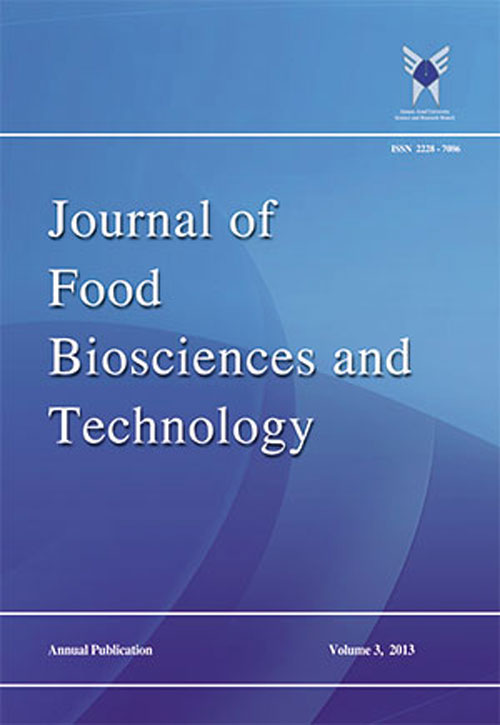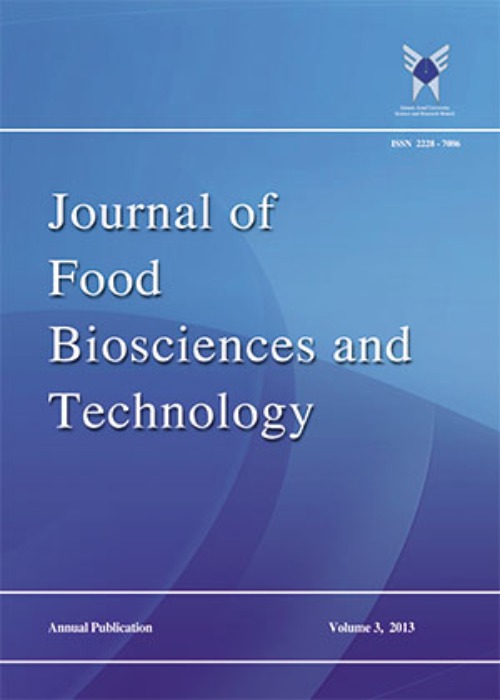فهرست مطالب

Journal of Food Biosciences and Technology
Volume:12 Issue: 2, Spring 2022
- تاریخ انتشار: 1400/11/15
- تعداد عناوین: 6
-
-
Characterization of a Traditional Egg-Free Crème Caramel Dessert Containing Chlorella protothecoidesPages 1-14
Crème caramel is sugar heated and turned into brown syrup to which milk and eggs are then added therefore each of its unit contains 200 kcal of energy for the consumer. Chlorella protothecoides is considered one of the commercially important microalgae due to its high nutritional potential and considerable energy content. This alga is used for the industrial production of lutein. Moreover, it contains high levels of fats, proteins, and fiber. It also has emulsifying properties for industrial applications. This research studied the effect of adding Chlorella protothecoides (0, 1, 2.5, and 4 gr/100 gr) on some properties of traditional crème caramel dessert. The results indicated that protein, calcium, phosphorous, and the oleic, linoleic, and linolenic fatty acids contents of the dessert increased when higher percentages of Chlorella protothecoides were added to its formulation (p<0.05). In general, the sample containing 4.0 gr/100 gr Chlorella protothecoides had higher overall acceptability score and titratable acidity, and more desirable nutritional properties compared to those containing lower percentages of this microalgae; it showed the maximum viscosity and protein content, the largest contents of carotenoid pigments, phosphorous, and calcium and the highest percentages of oleic, linoleic and linolenic fatty acids, and alpha-tocopherol.
Keywords: Chlorella protothecoides, Crème Caramel, Egg-Free, Nutritional Properties -
Pages 15-22
Application of gums-based edible coatings to food products before frying is a technique that can improve the nutritional quality and sensory parameters of fried products. In this study, the effect of wild sage seed mucilage (WSSM) concentration at three concentrations of 0.5, 1.0 and 1.5% as edible coatings and frying temperature at three degrees of 155°C, 170°C and 185°C on the oil uptake and color change kinetics of zucchini slices during frying process have been studied. The color indexes include a* (redness), b* (yellowness), L* (lightness), and color change intensity (ΔE) were used to calculate appearance changes of fried zucchini slices. WSSM Coating treatments decreased the oil uptake of fried zucchini slices about 21.80%. By increasing WSSM concentration from 0.0% to 1.5% significantly decreased the oil uptake of zucchini slices from 8.96% to 7% (P<0.05), while the moisture content of samples were increased from 83.97% to 86.18% with increasing gum concentration (P<0.05). The average ΔE index of fried zucchini slices increased from 30.45 to 65.63 with increasing frying temperature from 155°C to 185°C. The average surface change values of fried zucchini slices was 33.13% for the uncoated samples, in comparison 30.40%, 29.36%, and 27.97% were found for fried slices coated with 0.5, 1.0 and 1.5% WSSM, respectively. The best coating suspension and temperature frying for reducing the oil uptake of fried zucchini slices was 1.5% WSSM and 155°C, respectively.
Keywords: Color Indexes, Frying Process, Surface Change, Wild Sage Seed Mucilage -
Pages 23-38
Ice cream is the most popular dairy products. However, it can endanger people's health due to the high sugar content. Therefore, it is suggested that natural ingredients such as white mulberry juice, which has lower sugar and calories and healthier ingredients, be used in ice cream instead of sugar. In this study, white mulberry juice at 0, 25, 50, 75, and 100% substituted sugar consumption in the formulation of control samples, and physicochemical properties (pH, moisture, carbohydrate, lithium, potassium, brix, calories, and viscosity), total phenolic contents, antioxidant properties, overrun, melting resistance, color, and overall acceptance were evaluated one day after production. The results indicated that by increasing the content of white mulberry juice in the treatments, moisture, lithium, potassium, viscosity, total phenolic content, and antioxidant activity increased while pH, carbohydrate, brix, calories, overrun, melting resistance, and lightness decreased. There was no significant difference between the treatment containing 50% sugar and 50% white mulberry juice and the control sample in terms of overall acceptance score, the calorie content of the treatment was significantly lower than the control sample, and total phenolic content and antioxidant activity of the treatment were significantly higher than the control sample and selected as the optimal treatment.
Keywords: Functional, Ice Cream, Low-Calorie, sugar, White Mulberry Juice -
Pages 39-48
The present study aimed to investigate the effects of freezing speed and time on the deterioration indices such as Total Volatile Basic Nitrogen (TVB-N), Peroxide Value (PV), Thiobarbituric acid value (TBA), and pH, as well as the histological changes. Eighty Nile tilapias (Oreochromis niloticus) with approximate weight of 700 ± 50 g were caught from the saline water fish in research centre of Yazd, Iran in 2012. Then, the fillets were harvested and exposed to slow and quick freezing at 0.2 cm/h speed in the freezer at -18 °C during 18 hours, and 0.8 cm/h speed at -30 °C for 25 minutes, respectively. Finally, the fillets were transferred to -18 °C freezer where they were kept for 180 days. Based on the results, the changes in TVB-N, PV, TBA, pH and histological changes were less dramatic in the samples treated by quick freezing, compared to the slow freezing samples (p≤0.5).
Keywords: Chemical Quality, Freezing, Histological Change, SEM, Tilapia -
Pages 49-60
This study has aimed to determine the amount of flavonoids, anthocyanins, total phenolic compounds, ascorbic acid and antioxidant activity of the grape in the polar and nonpolar sub-fractions of methanolic extracts with two extraction methods, maceration and ultrasonic. The phenolic compounds content and antioxidant activity of selected grape (Vitis vinifera L. "Red Seedless") from Maragheh region, East Azerbaijan (Iran) were investigated with a view to their exploitation as a potential source of natural antioxidants. Antioxidant activities of the samples were determined by three testing systems namely DPPH, β-carotene/linoleic acid and reducing power assays. In the DPPH system, the highest radical scavenging activity was observed by the polar sub-fraction of the methanolic extract in frozen fruits (IC50 = 26.34 ± 6.5 μg/ml). In order to evaluate the efficiency of different methods for the extraction of the main polyphenols in grape, two methods were tested and compared. The results showed that the maceration method is better method as compared to the ultrasonic method. These advantages are visible on extracting of the flavonoids, anthocyanin, total phenolic, ascorbic acid contents and antioxidant capacity. Our findings demonstrate that the methanolic extracts of frozen and dried fruits of Vitis vinifera may be suggested as a strong potential source of natural antioxidant.
Keywords: Anthocyanin, Ascorbic Acid, Flavonoids, Grape, Total Phenols -
Pages 61-71
Magnetite (Fe3O4) is a magnetic Iron Oxide encountered in many technological applications. The particle size and shape of magnetite nanoparticles allow tuning their properties to different applications such as targeted drug delivery, cancer diagnostic, magnetic resonance imaging, catalysts, pharmaceuticals, biomedicine, and agriculture. During the last two decades, the biosynthesis of nanoparticles has received considerable attention due to the growing need to develop environmentally sociable technologies in nanoparticle synthesis. Therefore, there is a need for the development of an eco-friendly process to synthesize nanoparticles through green chemistry using plants and microorganisms. The research work involves the development of a simple and reliable method for the bio-fabrication of magnetic Iron Oxide nanoparticles (IO-NPS) through the green method using Achillea Nobilis extract. The crystalline structure and morphology of IO-NPS were studied using various characterization techniques i.e. Fourier Transform Infrared Analysis (FTIR), Ultraviolet spectroscopy studies (UV–vis), X-ray diffraction, and FESEM. The antibacterial and antioxidant activity of the iron oxide nanoparticles was determined. Iron Oxide nanoparticles exhibited potent antibacterial activity against gram-positive and gram-negative bacterial strains tested. From the results, this method can be applied to different medical and industrial applications.
Keywords: Antioxidant Activity, Antimicrobial Activity, Biosynthesis, iron oxide, Nanoparticle


